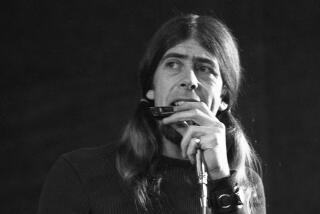John Hammond, Famed Record Producer, Dies
- Share via
John Hammond, the record producer, talent scout and critic credited with the discovery or promotion of musicians ranging from Count Basie to Bob Dylan and Bruce Springsteen, died Friday in his Manhattan apartment. He was 76.
At the time he died, said CBS spokesman Robert Altshuler, a longtime friend, Hammond was listening to a recording by Billie Holiday, the late and troubled singer who was one of Hammond’s major finds.
Hammond had been ill for some time. He suffered a stroke in 1985 but fought to recover, and a few months later was busy preparing a series of compact disc releases of vintage jazz recordings.
Despite the fact that he came from a wealthy family, he was as committed throughout his life to the fight for racial tolerance as he was to his constant search for musical talent.
“I am still the reformer,” he wrote in his 1977 autobiography, “the impatient protester, the sometimes intolerant champion of tolerance. Best of all, I still expect to hear a voice or a sound I have never heard before. . . .”
As a jazz producer for Columbia Records in the early 1930s, Hammond discovered Holiday, Basie, pianist Teddy Wilson, tenor saxophonist Lester Young and guitarist Charlie Christian. He first heard Holiday when she was only 17 and he was not quite 22.
Hammond, who was white, was a major factor in breaking down racial barriers in the dance band business, steering Wilson, Christian, vibraharpist Lionel Hampton and other black musicians into the wildly successful Benny Goodman orchestra. It was Hammond who urged Goodman to hire black bandleader Fletcher Henderson as an arranger.
Joined Group
Some top white sidemen--drummer Gene Krupa and pianist Jess Stacy--also joined the Goodman band at Hammond’s urging.
Goodman, who died last year, married Hammond’s sister, Alice, in 1942. She died in 1978.
Hammond discovered Basie in the mid-1930s when the latter was scarcely known outside Kansas City. Hammond heard the band when he picked up a Kansas City radio station in his car while driving one night.
But as the Swing Era slipped away, Hammond did not fade with it. He recorded Aretha Franklin when she was only 19. He discovered and signed for Columbia folk singer Pete Seegar, guitarist George Benson, Dylan and Springsteen.
Hammond was always known as a man of intense opinions and with few in-between feelings. Things were either “superb” and “marvelous,” jazz critic Leonard Feather observed in a 1983 piece on Hammond, or they were “dreadful” and “terrible.”
At that time, when he was 72, Hammond had lost little of “the boundless enthusiasm that has characterized his long love affair with music,” Feather wrote.
Hammond was born in New York City on Dec. 15, 1910. He went to Yale University and studied music at Juilliard. Barely out of college, he took over a theater where he presented shows featuring such black acts as Henderson’s band. In 1932, he persuaded Columbia to record Henderson.
He was a disc jockey, a columnist for the jazz magazine Down Beat and a music critic for various other publications. As an independent record producer for Columbia, he supervised recording sessions for Holiday, pianist Wilson and numerous others.
Hammond was intensely interested in the struggle of blacks for equality. He was a board member of the National Assn. for the Advancement of Colored People and covered the trial of the Scottsboro Boys for The Nation and The New Republic during the mid-1930s.
Played Viola
Although Hammond was not a professional musician himself, he was an accomplished viola player.
He left Columbia briefly during the 1940s to work with Mercury Records, then returned to Columbia and retired in the late 1970s. He spent some time running his own recording company, then served Columbia as a consultant.
He leaves two sons, Jason and blues performer John Paul Hammond.
More to Read
The biggest entertainment stories
Get our big stories about Hollywood, film, television, music, arts, culture and more right in your inbox as soon as they publish.
You may occasionally receive promotional content from the Los Angeles Times.










